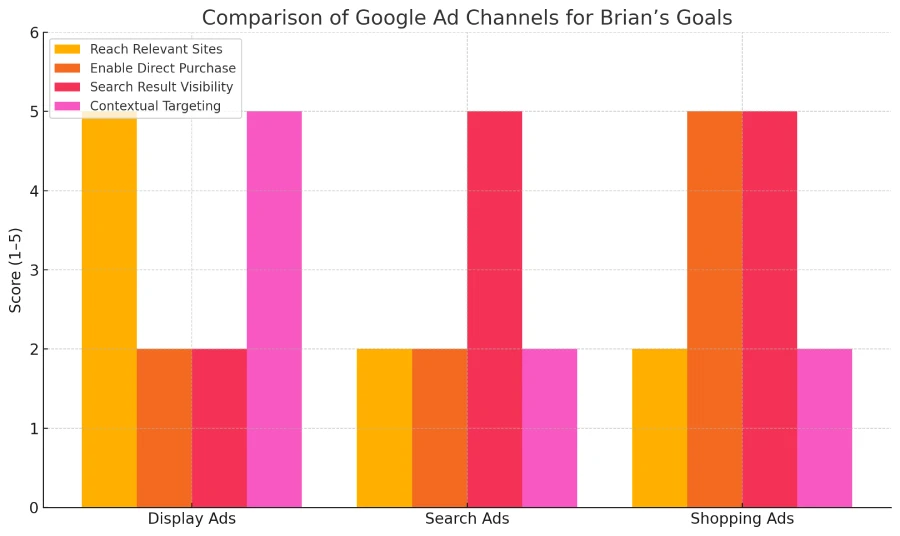I remember this question from my certification prep — and it immediately clicked with me because it shows exactly what Display Ads are built for: reaching people in the right context, not just when they’re searching.
For Brian, who’s selling low-cost bike parts, he doesn’t need flashy gimmicks. He needs scale, relevance, and visibility on bike-related websites, which Display Ads do perfectly. Let’s start,
Question
Brian owns a company that makes inexpensive replacement parts for bicycles. He’s ready to increase the scale of his business and wants to use Google Display Ads to drive sales. Which feature of a Google Display Ads will help Brian achieve his business objectives?
- His ads can enable customers to purchase his products directly from within the ad.
- His ads can appear on Google Search results when customers are searching for specific search terms.
- His ads can appear on websites relevant to bicycles, and therefore connect him to his potential audience.
- His ads can contain proprietary formatting that allow him to precisely demonstrate how his products work.
Here is the correct answer:
His ads can appear on websites relevant to bicycles, and therefore connect him to his potential audience.
Why This Answer Is Correct:
Google Display Ads don’t just show on random websites — they can be strategically targeted to appear on:
- Niche blogs
- Review sites
- How-to articles
- Product forums
- Shopping sites about bikes and gear
This means Brian’s ad for “$9.99 bike seat replacement” could appear on:
🧾 “Top 10 Budget Bike Seats Under $20”
🛠️ “How to Replace Your Bike Pedals”
So even if someone isn’t actively searching on Google, they see his product where it makes sense.
That’s contextual advertising — and it’s a superpower of the Display Network.
Why the Other Options Are Wrong:
🚫 Option 1: His ads can enable customers to purchase directly within the ad.
Enable customers to purchase directly in the ad
While this sounds convenient, it’s not a feature of standard Display Ads. Purchase options directly in an ad are typically part of Shopping Ads or Buy on Google programs. Display Ads will send users to Brian’s landing or product page, not process the transaction inside the ad.
🚫 Option 2: His ads can appear on Google Search results
That’s for Search Ads. Display Ads are designed to show across the Google Display Network — a collection of over 2 million websites, apps, and YouTube. They’re ideal for visual branding and context-based targeting, not search intent capture.
🚫 Option 4: Ads can contain proprietary formatting
This is misleading. Display Ads allow some visual flexibility (especially in Responsive Display Ads), but they don’t support special interactive formatting to showcase how a product works in detail. For that, video ads or your landing page would be more appropriate.

Visual Comparison Table:
| Feature / Statement | True for Display Ads? | Why / Why Not |
|---|---|---|
| Appear on niche/relevant websites (e.g., bike-related) | ✅ Yes | Core advantage of contextual & topic targeting |
| Enable in-ad purchases | ❌ No | Only possible in some Shopping ads, not Display |
| Appear in Google Search results | ❌ No | That’s Search Network territory |
| Use proprietary formatting to demonstrate product function | ❌ No | Display Ads use flexible or standard formats, not custom UX |
Real-Life Example:
Brian owns BikeFixPro, a small brand that sells affordable parts online. He wants to scale without a big video budget or fancy app.
He runs responsive display ads with:
- Images of common products (tires, chains, pedals)
- Headlines like “Affordable Bike Parts – From $5.99”
- Audience targeting like:
- Topics: Cycling, Mountain Biking, Bicycle Maintenance
- Placements: Bike maintenance blogs, YouTube cycling tutorials
- Custom intent keywords: “replace bike pedals,” “budget bike seats”
Now, his ads appear when people are already thinking about bike repairs — even if they aren’t searching yet.
Helpful Resources:
- Google Ads Help – About Display Ads
- Google Reaching Intent Before Search
- Google Ads Skillshop – Display Certification Course
Conclusion:
For business owners like Brian, Google Display Ads offer powerful targeting that helps connect products with the right audience at scale. Whether someone is watching a video on fixing bike brakes or reading a review of the best budget pedals, Brian’s ads can appear there.
✅ Use Display Ads when you want visibility, relevance, and reach — even before someone enters a search query.
Now, if you are ready, you can take the Google Skillshop test for the Google Ads Display Exam. Want more real exam questions with easy answers like this? Follow along — I’ll be breaking down more Google Ads Display Measurement Certification Free examples in the next posts.
FAQs
Q1: What’s the advantage of showing ads on relevant websites?
It ensures your ad is contextual and timely. People are more likely to click if they’re reading or watching content related to what you sell.
Q2: Can Display Ads sell products directly?
Not inside the ad. Users click the ad to be taken to your store or product page. For checkout within an ad, consider Shopping Ads.
Q3: Should Brian only use Display Ads?
No. Display Ads are best for top-of-funnel awareness. Brian should combine them with Search Ads to capture demand when users are ready to buy.
Q4: Can Brian control which sites his ad appears on?
Yes! Google lets him choose specific sites (placement targeting), topics, or interest-based audiences. He can even exclude irrelevant sites for better performance.
